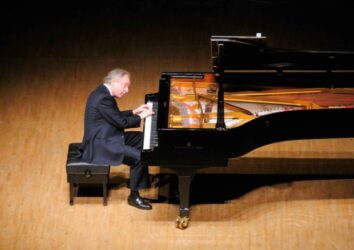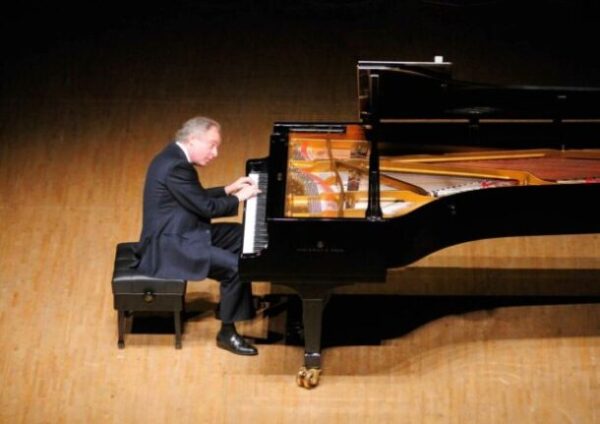 United Kingdom Bach, Mozart, Haydn, Beethoven: András Schiff (piano). Sheldonian Theatre, Oxford 15.2.2023. (CR)
United Kingdom Bach, Mozart, Haydn, Beethoven: András Schiff (piano). Sheldonian Theatre, Oxford 15.2.2023. (CR)

Bach – Goldberg Variations, BWV988 – Aria; Capriccio in B-flat major ‘Capriccio on the departure of a beloved brother’, BWV992; A Musical Offering, BWV1079 – Ricercar a 3; Chromatic Fantasia and Fugue in D minor, BWV903
Mozart – Piano Sonata in B-flat major, K570; Fantasia in C minor, K475
Haydn – Piano Sonata in C minor, Hob XVI:20; Variations in F minor, Hob XVII:6
Beethoven – 6 Bagatelles, Op.126
It takes same bravado perhaps for a performer not to announce in advance what their programme will be. But then, there are few pianists on the international circuit of the stature of András Schiff, whether based in Britain or elsewhere, and fortunately a near-capacity audience at Oxford’s Sheldonian Theatre was willing to pay its money and take its chance.
In the event, the repertoire was entirely characteristic of this musician, clearly devised and delivered with careful thought as to how the sequence of pieces would follow one another, although the fact that the programme was only announced by Schiff immediately before the performance of each item, with some commentary, lent the recital an apparent air of spontaneity and drawing room intimacy, enhanced by his playing entirely from memory. He started with one of his calling cards, the opening Aria from the Goldberg Variations, in a performance of easy, contented facility.
He moved on to an early keyboard work by Bach, the Capriccio ‘on the departure of a beloved brother’ (c.1704) said to have been composed when his brother left the family home to join the Swedish army. The broad, lyrical first section was enlivened by spirited observation of the French-style ornaments, before the more serious Passacaglia gave sonorous voice to the repeated theme in the bass, in alternation with the right hand’s sweeter counterpoint in variation which emerged like an operatic lament. A brief connecting passage – like a recitative – led to the ‘Aria di postiglione’, with the characteristic postillion call elaborated with further ornaments in its repeated sections, giving way to a determined and emphatic manner with the concluding fugue which also uses a distinctive post horn figure as its subject.
There followed the Piano Sonata No.17 by Mozart, whose Classicism seems a whole world away from Bach, especially in the particularly refined simplicity of the composer’s ‘late’ period as exemplified in this composition from 1789. But Schiff made the subtle connections clear in his playing, apart from the fact that this Sonata shared the key of B-flat with Bach’s Capriccio. Like the concluding sections of the latter, the first two movements of the Sonata each play around with a falling arpeggio figure that is not unlike a fanfare: Schiff registered its fragmentary iterations in the first firmly and cautiously, like the recurring appearances of a melodic subject in a fugue; whilst the harmonised melody of the second was played solemnly. In both cases Schiff made the contrasting responses to those themes in the music pointedly insistent or invigorated, giving the work structural tension and dynamism. The finale brought well-judged relief in its delightful and authentically Mozartian insouciance, contrasting with a mock seriousness in the intervening episodes.
Schiff then drew the connection between the two composers more explicitly by juxtaposing the Ricercar a 3 from A Musical Offering – in a finely controlled account that was more openly projected towards the end – with Mozart’s Fantasia K475 in the same key of C minor, pointing out the similarity between its opening theme and the ‘Royal Theme’ upon which the whole of A Musical Offering is based. Like the Ricercar, the Fantasia received a formidably integrated interpretation, despite Schiff’s rightly pointing out its varied operatic qualities as though a distillation of Don Giovanni in seven minutes. Fantasy and intellectual contrapuntal rigour were recapitulated at the end of the concert’s first half in Bach’s Chromatic Fantasia and Fugue, although the former section was played with relative restraint, and not as wildly as some interpretations. The fugue gradually unfurled, developing its own indefatigable momentum and logic, with ever more traction and dynamic projection, despite the tempo remaining steady, rather like the manner in which Karl Richter structured his performances of Bach’s similar compositions for the organ.
The sombre character established by the latter pieces was carried over into the second part after the interval, in the two major works featured, both by Haydn. First was the Piano Sonata in C minor (1771) which Schiff cited as an important milestone in the history of this genre. Although Beethoven famously, and dyspeptically, stated that he learnt nothing from his teacher, Haydn’s output so often provides a precedent for many of his radical advances, and this Sonata surely served as a point of inspiration for the ‘Pathétique’, nearly 30 years later, and written in the same key at that. There is a certain degree of stress and agitation (the Sonata clearly influenced by the Sturm und Drang movement) but Schiff kept that under control and avoided instilling an anachronistic, Beethovenian fury – the principal subject yearning and melancholic, and allowing the more driven triplets subsequently to take on their own momentum. The slow movement (in the soft key of A-flat, like the equivalent of the ‘Pathétique’) was fairly brisk and matter of fact, with its gently oscillating accompaniment and the long sequences of syncopations (looking as far ahead as Schumann perhaps) generating drama from within the music, before a similarly terse finale.
Schiff gave a flowing account of the F minor Variations, with a palpable but gentle tread in its theme, and almost a droll character in the alternating major key sections rather than drawing a stark contrast between the two. Beethoven closed the recital with, paradoxically, perhaps the least consequential work here, the 6 Bagatelles Op.126. They were no mere trifles in Schiff’s hands however, but stemmed from the same inner, transcendental world as the composer’s last three sonatas for piano, written not long before the Bagatelles. Where the first was almost weary despite its apparent cheerfulness, the humour in the others was observed – although restrained and wry – and the furious energy of the fourth was allowed to come over as skittishness rather than rage. At the centre was a still, hymn-like performance of the third, with a Schubertian songfulness emerging in the melody over its chords. Like the recital overall, Schiff’s performance was consistently insightful and unflustered.
Curtis Rogers
